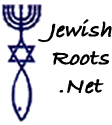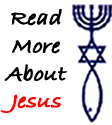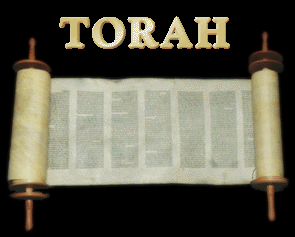






![]()
 Over the years, the word "torah" has been used for different things. In most cases, it is a word used to define collectively the first five
books of Moses. Those are Bereishit (Genesis), Shemot (Exodus), Vayikra
(Leviticus), Bamidbar (Numbers), and Devarim (Deuteronomy). Sometimes the entire Old Testament is called the torah, but this
body of Jewish books is usually known as the Tanach or Tanakh.
Over the years, the word "torah" has been used for different things. In most cases, it is a word used to define collectively the first five
books of Moses. Those are Bereishit (Genesis), Shemot (Exodus), Vayikra
(Leviticus), Bamidbar (Numbers), and Devarim (Deuteronomy). Sometimes the entire Old Testament is called the torah, but this
body of Jewish books is usually known as the Tanach or Tanakh.
When someone is studying the torah, they study scripture,
usually from the first five books.
Sometimes the word torah is used to mean instruction or guide. Many times in the Hebrew Bible the word torah is used to mean law.
 There is such a thing as a torah. It is a scroll similar to the
pictures on this page. The torah picture at the top is opened up to show columns of Hebrew
scripture. When it is time for someone to read from the torah, this is how it
is done. The torah is removed from its protective environment or undressed. Usually the torah
is kept in a special wooden cabinet that is known as an ark. The ark is usually
raised up a little higher than the altar and ornamental in appearance. In
most houses of worship the ark is placed on the east side of the room. We place
the torah inside the protective ark because the
second set of stone tablets given to Mosses at Mt. Sinai were carried in a
protective ark known as the Ark of the Covenant. The torah itself has its own special cover
that can be decorated in a variety of ways.
There is such a thing as a torah. It is a scroll similar to the
pictures on this page. The torah picture at the top is opened up to show columns of Hebrew
scripture. When it is time for someone to read from the torah, this is how it
is done. The torah is removed from its protective environment or undressed. Usually the torah
is kept in a special wooden cabinet that is known as an ark. The ark is usually
raised up a little higher than the altar and ornamental in appearance. In
most houses of worship the ark is placed on the east side of the room. We place
the torah inside the protective ark because the
second set of stone tablets given to Mosses at Mt. Sinai were carried in a
protective ark known as the Ark of the Covenant. The torah itself has its own special cover
that can be decorated in a variety of ways.
The torah is considered to be very, very holy. It must be treated with the utmost respect. It can never; never touch the ground or else all who view this tragic event should fast. It is perhaps the holiest of any Jewish items used in worship.
People hold the torah, kiss the torah, raise it up in the air, and even sing. During some holidays, people even dance with the torah because they are happy.
King David danced while leading the Ark of the Covenant, which contained the torah (2 Sam 6:14). Torah's come in different sizes and with different covers on them. A torah can cost thousands of dollars. Sometimes a congregation has several torahs in its ark.
![]() The actual torah parchment itself is never touched by human hands. After a scribe creates the torah, people who read (or chant using a
special torah tune) from it use what is called a yad. This is a metal tubular
device that has what looks like a hand on the end of it with a finger protruding
out. As the reader moves from word to word he can keep his place by using the
yad instead of his own finger. This is because human hands have oil on them and
can damage the parchment. The torah is handled by the wooden handles that the
scroll is attached to.
The actual torah parchment itself is never touched by human hands. After a scribe creates the torah, people who read (or chant using a
special torah tune) from it use what is called a yad. This is a metal tubular
device that has what looks like a hand on the end of it with a finger protruding
out. As the reader moves from word to word he can keep his place by using the
yad instead of his own finger. This is because human hands have oil on them and
can damage the parchment. The torah is handled by the wooden handles that the
scroll is attached to.
Reading (or layning) the torah is considered very difficult. That is because the Hebrew writing contains no vowels and the reader must use a little bit of memorization from his study of that particular passage during the preceding week. The reader can study with a different text that contains the vowels throughout the week, but when it comes time to read from the torah he must actually use the torah. There are others close by using the books with the vowels to help correct him if a mistake is made in the pronunciation of a word. Often a bar or bat mitzvah child will receive the honor of reading from the torah on this special occasion, even if only a very short part is read. It is mostly symbolic.
Some congregations read the entire torah in one year. This is done by dividing the torah into 54 sections known as parshas. Some weeks there is a double parsha. When you read the last Parsha, it is time to celebrate with the holiday Simchat Torah.
It is a wonderfully thing to study the words of the Torah.
There is also a Torah Reading Chart to help understand what reading from the Prophets should be read along with the Torah passage for the week.